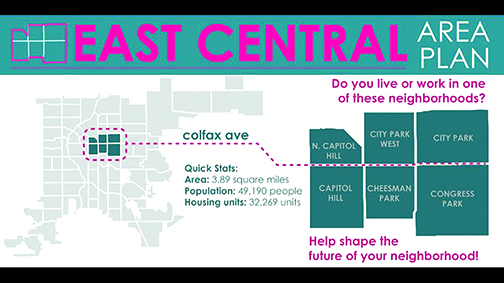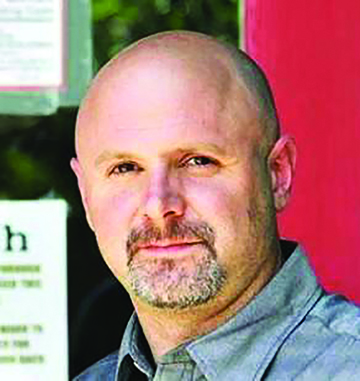by Robert Davis
In October, city council adopted the East Central Area Plan (ECAP), a land use policy document authored by Community Planning and Development (CPD) that is meant to guide growth in the Capitol Hill, North Capitol Hill, Cheesman Park, Congress Park, City Park, and City Park West neighborhoods over the next 20 years.

The area is comprised of more than 32,000 housing units, most of which are occupied by young renters, and runs between Broadway and Colorado Ave., from 7th Ave. up north to 23rd Ave.
And while the plan is supported by several neighborhood organizations, many residents feel left out, saying the plan doesn’t represent the needs their communities.
“We have serious concerns this plan was put together with a predetermined outcome in mind,” Jesse Morreale, president of the 7th Ave. Neighborhood Association (7ANA), told city council. “To us, this plan represents the city directing its agencies in ways that will harm our neighborhood.”
The plan makes six priority recommendations: strengthen the local economy through job training, increase affordable housing, improve services for people experiencing homelessness, make streets safer, expand historic preservation, and reduce carbon pollution.
District 9 representative Candi CdeBaca questioned the ability of the plan to accomplish the goals it sets out to accomplish.

“We have multiple plans across the city that try to address the inequities in Denver’s zoning code, but when it comes to rezoning, our plans don’t come with any guarantee to achieve our goals, and they’re not yielding any results,” she said.
Left Out
Morreale and volunteer 7ANA board member Mark Spear both claimed CPD left their neighborhood in the dark about ECAP, even though the plan recommends several consequential changes for the area.
The 7th Ave. corridor is one of many streets classified as a transformative opportunity, a designation representing a need for increased multi-modal transportation in the area. Some ideas mentioned in the plan include building buffered bike lanes and other traffic calming designs that increase safety for pedestrians.
Morreale says these changes will increase density and property values in the area and thereby push out a lot of cost-burdened residents.

“It’s amazing to me that city council would try to pass a plan of this magnitude without consulting all the people it affects,” Spear said.
Curt Upton, the principal city planner overseeing of ECAP, said CPD determined its outreach efforts by analyzing demographic trends in the comments residents submitted during community meetings.
Upton said CPD’s outreach meetings were primarily attended by property owners even though there are far more renters in the area. This fact alone made it necessary for CPD to focus its efforts on young renters, Upton said.
Other residents were concerned with the way CPD decided to define the neighborhoods ECAP will affect.
Instead of defining the plan area by the boundaries of neighborhood organizations, CPD used Statistical Neighborhood boundaries, which the agency created in the 1970s as a part of the Community Redevelopment Program.
Upton said CPD decided to use Statistical Neighborhood boundaries because they align with census tracts, thereby giving the agency access to data on the area’s demographic change.
“This plan is looking 20 years into the future, and hopefully by then we aren’t still in a housing crisis,” he added.
Historical Displacement
Many other residents believe ECAP will increase displacement because the plan’s transportation plans will increase investment and historic preservation in neighborhoods vulnerable to displacement like North Capitol Hill and City Park West.
“I remember a time when nobody cared about this neighborhood,” Julie Untiedt, volunteer president of the City Park West Neighborhood Association, told city council. “Now that the land is worth something, everyone wants to go changing the neighborhood.”
ECAP will focus on helping North Capitol Hill and City Park West meet Denver’s equity goals of providing multimodal transportation for residents and access to healthy food options. The plan also envisions high-comfort bike lanes running east-to-west through City Park West and North Capitol Hill along 16th Ave., and north-to-south along Franklin St. and Pennsylvania St., respectively.
As for the Colfax corridor, ECAP recommends rezoning the area to increase building height sizes up to eight stories. However, ECAP requires developers to provide a “community benefit” before they can build up. The plan does not specifically define what a community benefit is, but provides affordable business spaces, grocery stores, and daycare as examples. City council will have the authority to determine what benefit a developer must provide before approving a rezoning request.
The plan will also transform Colfax into a bus rapid transit system corridor, with stops at nearly every intersection between Broadway and Colorado Blvd. When combined with the historic preservation measures, some residents are concerned the cost of living will negatively impact the neighborhood’s small businesses.
“The thing that worries me the most is that small business owners will sell out, smart developers will scoop up their property, taxes will increase, and residents will face displacement for no reason whatsoever,” Dr. Giles Rafsnider told the Glendale Cherry Creek Chronicle in an interview.
Upton verified these fears when he told city council that Denver doesn’t have the policy tools to address displacement of minority groups or small businesses. And, even though CPD discussed ECAP alongside concurrent efforts like the Missing Middle Housing Initiative and the Affordable Housing Zoning Incentive, the agency doesn’t fully understand how ECAP will impact other plans or legislative efforts.
During the 2020 session, Democrats in the General Assembly introduced legislation to overturn the Telluride Decision, a state Supreme Court ruling that struck down rent control policies.
However, Upton says, CPD believes its plans are flexible and capable of being molded to fit modern needs.
“As additional tools like state laws change, it’s only going to accelerate our efforts to provide affordable housing,” Upton said.
